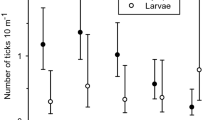Abstract
A common method for sampling tick populations is flagging, which is a method of dragging a white cloth over a plant substrate for a fixed distance along a transect. Flagging over rough physical surfaces or using long subtransect lengths could lead to the underestimation of tick densities. Using estimates of the drop-off rates of adult Ixodes pacificus in flag sampling, optimal sampling schemes (the length and number of subtransects) were examined using the relationships between the tick drop-off rates (c), the tick density and distribution patterns and the roughness of the sampled plant substrate. It was found that the optimal number of subtransects and Lmax, the longest subtransect length which did not significantly underestimate the tick density from c, were affected by the tick density, substrate roughness and tick distribution pattern. This study also showed that the density and distribution of I. pacificus and Dermacentor occidentalis varied greatly over time in the populations sampled, while the Dermacentor variabilis densities were low and showed no significant changes over time. Both I. pacificus and D. occidentalis had clumped distributions along trails and these clumps were aggregated. However, the clump sizes (or individual clump areas) changed significantly over time because of density fluctuation or the movement of ticks. Finally, a positive association between the number of I. pacificus and D. occidentalis adults was observed from 2 m subtransect flag collections in March 1995; no relationship was found in 1994. © Rapid Science Ltd. 1998
Similar content being viewed by others
REFERENCES
Bard, Y. 1974. Nonlinear Parameter Estimation. Academic Press, New York/London.
Carroll, J.F., Russek-Cohen, E., Nichols, J.D. and Hines, J.E. 1991. Population dynamics of American dog ticks (Acari: Ixodidae) along park trails. Environ. Entomol. 20: 922-929.
Fourie, L., Kok, O.B. and van Zyl, J.M. 1991. Spatial distribution of the Karoo paralysis tick Ixodes rubicundus(Acari: Ixodidae) within a false upper Karoo veld type. Exp. Appl. Acarol. 11: 37-49.
Fourie, L., van der Lingen, F. and Kok, D.J. 1995. Improvement of field sampling methods for adult Karoo paralysis ticks, Ixodes rubicundus(Acari: Ixodidae), through addition of host odor. Exp. Appl. Acarol. 19: 93-101.
Ginsberg, H.S. and Ewing, C.P. 1989. Comparison of flagging, walking, trapping and collecting from hosts as sampling methods for northern deer ticks, Ixodes dammini, and lone star ticks, Amblyomma americanum(Acari: Ixodidae). Exp. Appl. Acarol. 7: 313-322.
Gray, J.S. 1985. A carbon dioxide trap for prolonged sampling of Ixodes ricinusL. populations. Exp. Appl. Acarol. 1: 35-44.
Iwao, S. 1972. Application of the m*-mmethod to the analysis of spatial patterns by changing the quadrate size. Res. Popul. Ecol. 14: 97-128.
Karandinos, M.G. 1976. Optimal sample size and comments on some published formulae. Bull. Entomol. Soc. Ann. 22: 417-421.
Kinzer, D.R., Presley, S.M. and Hair, J.A. 1990. Comparative efficiency of flagging and carbon dioxide-baited sticky traps for collecting lone star tick, Amblyomma americanum(Acarina: Ixodidae). J. Med. Entomol. 27: 750-755.
Kramer, V.L. and Beesley, C. 1993. Temporal and spatial distribution of Ixodes pacificusand Dermacentor occidentalis(Acari: Ixodidae) and prevalence of Borrelia burgdorferiin Contra Costa county, California. J. Med. Entomol. 30: 549-554.
Kuno, E. 1991. Sampling and analysis of insect populations. Ann. Rev. Entomol. 36: 285-304.
Lane, R.S., Emmons, R.W., Dondero, D.V. and Nelson, B.C. 1981. Ecology of tick-borne agents in California. I. Spotted fever group rickettsia. Am. J. Trop. Med. Hygiene 30: 239-252.
Legendre, L. and Legendre, P. 1983. Numerical Ecology. Elsevier Scientific Publishing Company, Amsterdam, New York.
Milne, A. 1943. The comparison of sheep-tick populations (Ixodes ricinusL.). Ann. Appl. Biol. 30: 240-250.
Philip, R.N., Lane, S. and Casper, E.A. 1981. Serotype of tick-borne spotted fever group rickettsia from western California. Am. J. Trop. Med. Hygiene 30: 722-727.
Schmid, G.P., Kornblatt, A.N., Connors, C.A., Patton, C., Carney, J., Hobbs, J. and Kaufmann, A.F. 1983. Clinically mild tularemia associated with tick-borne Francisella tularensis. J. Infect. Dis. 148: 63-67.
Solberg, V.B., Neidhardt, K., Sardelis, M.R., Hildebrandt, C., Hoffmann, F.J. and Boobar, L.R. 1992. Quantitative evaluation of sampling methods for Ixodes damminiand Amblyomma americanum(Acari: Ixodidae). J. Med. Entomol. 29: 451-456.
Sonenshine, D.E. 1982. Current Topics in Vector Research, Vol. II. Praeger, New York.
Southwood, T.R.E. 1978. Ecological Methods: With Particular Reference to the Study of Insect Populations. Chapman & Hall, London and New York.
SYSTAT Inc. 1990. SYSTAT: The System for Statistics. SYSTAT, Inc., Evanston, Il.
Taylor, L.R. 1984. Assessing and interpreting the spatial distributions of insect populations. Ann. Rev. Entomol. 29: 321-327.
Taylor, L.R., Woiwid, I.P. and Perry, J.N. 1978. The density dependency of spatial behaviour and temporal variance/mean population parameters. J. Animal Ecol. 47: 383-406.
Tsunoda, T. 1993. Sampling efficiency of the tick, Haemaphysalis longicornisNeumann, by flagging method. Japan. J. Ecol. 43: 189-192.
Uspensky, I. 1993. Ability of successful attack in two species of Ixodid ticks (Acari: Ixodidae) as a manifestation of their aggressiveness. Exp. Appl. Acarol. 17: 673-683.
Author information
Authors and Affiliations
Rights and permissions
About this article
Cite this article
Li, X., Dunley, J.E. Optimal sampling and spatial distribution of Ixodes pacificus, Dermacentor occidentalis and Dermacentor variabilis ticks (Acari: Ixodidae). Exp Appl Acarol 22, 233–248 (1998). https://doi.org/10.1023/A:1006018432064
Issue Date:
DOI: https://doi.org/10.1023/A:1006018432064




